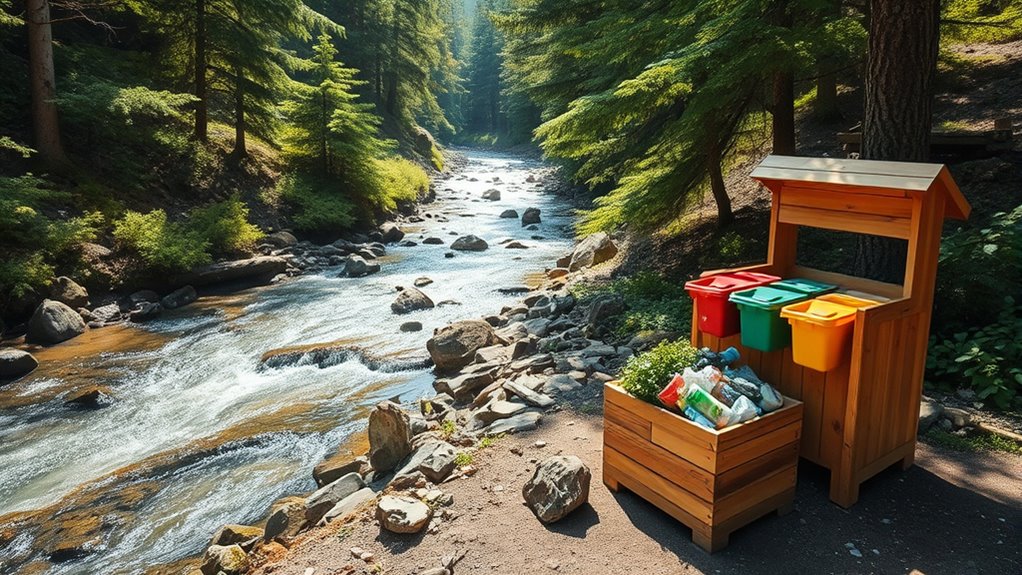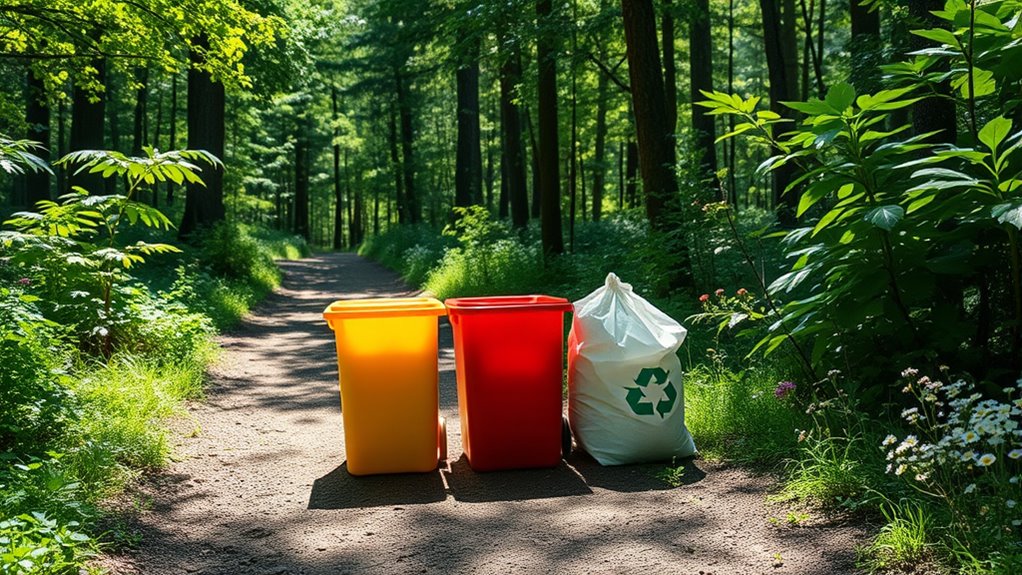Proper waste disposal is essential for protecting natural environments and adhering to Leave No Trace principles. Always carry out all waste, including biodegradable materials, and choose reusable items over disposables. Sort and clean recyclables according to local guidelines to prevent contamination. In remote outdoor settings, plan ahead by bringing designated containers for waste and recyclables. Consistently practicing these strategies helps preserve ecosystems and sustain future outdoor activities—continue to learn how responsible waste management supports environmental health.
Key Takeaways
- Carry out all waste, including biodegradable materials, to prevent environmental impact and adhere to Leave No Trace principles.
- Use reusable containers and utensils to minimize disposable waste in outdoor settings.
- Pre-plan waste disposal and recycling options, especially in remote areas with limited facilities.
- Properly sort, clean, and dispose of recyclables to enhance recycling efficiency and reduce landfill contamination.
- Follow local guidelines and regulations for waste disposal to support environmental preservation and sustainability.

Effective waste management is essential to preserving natural environments and maintaining the principles of Leave No Trace. When engaging in outdoor activities or managing waste in everyday life, understanding and implementing effective waste reduction and recycling strategies is critical. Waste reduction involves minimizing the amount of waste generated from the outset. This can be achieved by choosing reusable items over single-use products, such as water bottles, utensils, and containers, which significantly cuts down the volume of waste that needs disposal. Additionally, planning activities to avoid excess packaging and opting for eco-friendly alternatives contribute to waste reduction efforts. These strategies not only lessen the burden on waste disposal systems but also reduce the likelihood of environmental contamination and habitat disruption.
Minimize waste by choosing reusable items, planning ahead, and using eco-friendly alternatives to protect our environment.
Recycling strategies are equally fundamental within a thorough waste management plan. Proper recycling ensures that materials like plastics, metals, paper, and glass are diverted from landfills and reprocessed into new products. To maximize effectiveness, you must familiarize yourself with local recycling guidelines, as regulations vary by region. Sorting waste correctly and cleaning recyclables before disposal prevent contamination, which can make entire batches unrecyclable. Implementing source separation at the point of disposal enhances recycling efficiency and reduces the need for energy-intensive processing. Furthermore, understanding which materials are recyclable and avoiding contamination helps maintain the integrity of recycling streams, ensuring that valuable resources are recovered rather than wasted. Incorporating environmentally friendly waste disposal methods, such as composting biodegradable waste, further supports sustainable practices.
In outdoor environments, these strategies become even more essential. Leave No Trace principles emphasize that waste should be minimized and properly disposed of to prevent environmental degradation. When packing for outdoor activities, you should aim to carry out all waste, including biodegradable materials that might otherwise be left behind. Carrying reusable containers and utensils reduces the reliance on disposable items, aligning with waste reduction goals. Recycling options may be limited in remote areas, so pre-planning is necessary; for instance, bringing designated containers for waste and recyclables helps guarantee proper disposal once you return to areas with appropriate facilities.
Ultimately, integrating waste reduction and recycling strategies into your routine fosters responsible stewardship of natural spaces. By consciously reducing waste generation and practicing proper recycling, you contribute to healthier ecosystems and uphold the Leave No Trace ethic. These practices require deliberate effort but are essential for preserving the beauty and integrity of the environment for future generations. Proper waste management isn’t just about disposal—it’s about proactively minimizing environmental impact through strategic choices, ensuring that natural landscapes remain pristine and resilient. Engaging in eco-friendly practices, such as using renewable resources, further enhances your contribution to environmental preservation.
Frequently Asked Questions
How Can I Identify Biodegradable Versus Non-Biodegradable Waste?
You can identify biodegradable waste by looking for composting methods or organic labels, indicating materials that break down naturally. Non-biodegradable waste typically lacks these signs and may feature recycling symbols with numbers, guiding proper disposal. Analyze packaging and materials carefully; biodegradable items often include food scraps, paper, or natural fibers, while plastics and certain synthetic materials are non-biodegradable. Properly sorting waste guarantees effective composting and recycling efforts.
What Are the Best Practices for Disposing of Hazardous Materials?
Did you know that over 400 million tons of hazardous waste are generated globally each year? Proper disposal methods are vital; you should never pour hazardous waste down drains or onto the ground. Instead, use designated hazardous waste disposal facilities, follow local regulations, and wear protective gear. Always label containers clearly, and consult professionals for disposal when in doubt. This guarantees safety for you and the environment.
How Do Waste Disposal Regulations Vary by Location?
You need to recognize that waste disposal regulations vary by location, influenced by local laws and environmental policies. Recycling programs may differ, with some areas emphasizing curbside collection and others requiring drop-off centers. Landfill regulations also vary, impacting how waste is processed and contained. Understanding these regional differences helps guarantee compliance and promotes responsible waste management, aligning your actions with local environmental standards and supporting community sustainability efforts.
What Should I Do With Waste in Areas Lacking Trash Receptacles?
In areas lacking trash receptacles, you should prioritize Leave No Trace principles by carrying out all waste. Pack waste in designated bags, secure it tightly, and carry it with you until you find responsible disposal options. This approach minimizes environmental impact and maintains area cleanliness. Always plan ahead by bringing supplies for waste management, ensuring responsible disposal and adherence to Leave No Trace guidelines, even in remote or unserviced locations.
How Can I Reduce Waste Generation During Outdoor Activities?
Imagine a pristine trail where your footprints leave only memories. To reduce waste during outdoor activities, opt for reusable containers instead of single-use plastics, and choose biodegradable packaging for snacks. These choices minimize your ecological footprint, conserve resources, and keep nature untouched. By planning ahead and bringing minimal packaging, you actively contribute to preserving the environment’s beauty, ensuring future explorers enjoy the same unspoiled landscape you cherish today.
Conclusion
By properly disposing of waste, you uphold the Leave No Trace principle and safeguard our environment for future generations. Think of it as your moral compass guiding you through the wilderness, much like a trusty lantern in the dark. Every action counts—whether it’s packing out trash or choosing eco-friendly options. Remember, your responsible behavior today ensures our planet remains pristine, just like the noble explorers of yore who cherished and preserved the natural world for all to enjoy.










